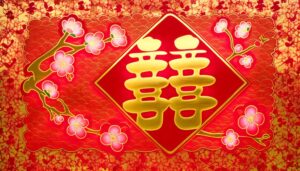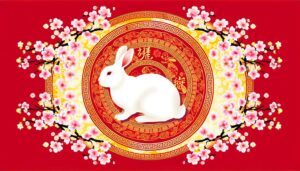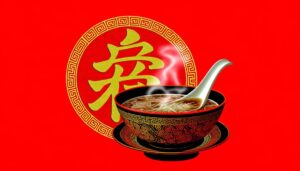How to Draw the Chinese Tiger Symbol – A Step-by-Step Guide
The tiger symbol in Chinese culture epitomizes power, courage, and protection. Historically, tigers have been depicted in bronze ware, jade carvings, and military insignia, symbolizing strength and martial prowess.
In mythology, the White Tiger signifies virtue and supernatural strength, serving as a guardian against evil spirits. Chinese astrology associates the tiger with bravery and passion.
Representations in art and literature often highlight the tiger's valor and spiritual essence. Modern interpretations continue to emphasize leadership and resilience, underscoring its enduring cultural importance.
To uncover the multifaceted influence of the tiger in Chinese culture, explore its rich historical and symbolic contexts further.

Key Takeaways
- The tiger symbolizes power, courage, protection, strength, and royalty in Chinese culture.
- Tigers serve as guardians and symbols of bravery, warding off evil spirits in folklore and Feng Shui.
- In Chinese astrology, tigers are linked to bravery, passion, and assertiveness.
- Tigers are deeply integrated into festivals like Lunar New Year, reflecting their enduring cultural significance.
- Artistic and literary representations of tigers depict themes of strength, valor, and protection.
Historical Significance
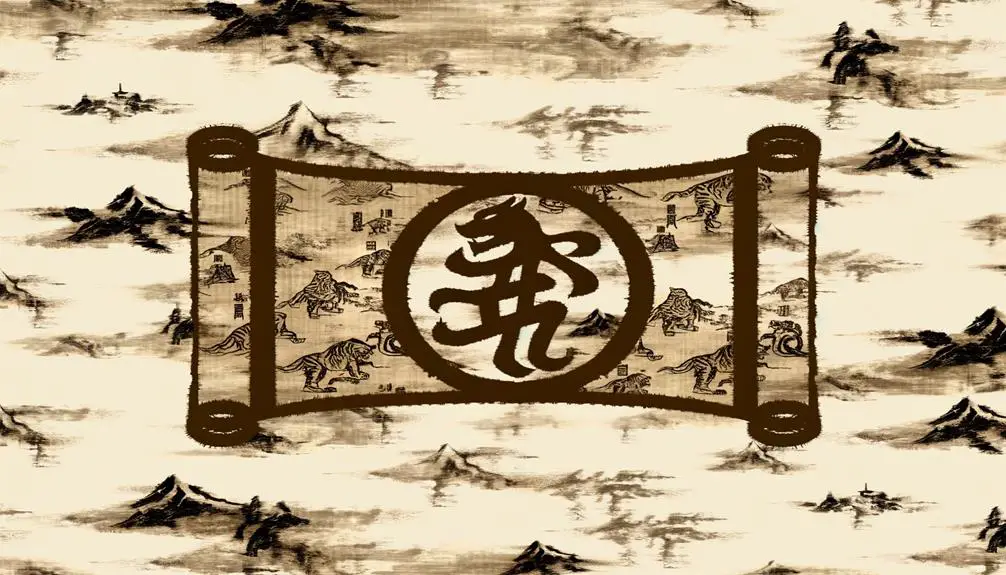
The tiger, represented by the character 虎 (hǔ) in Chinese, has held a prominent position in Chinese culture and history for millennia, symbolizing power, courage, and protection.
Historically, this majestic animal has been deeply embedded in various facets of Chinese society. During the Zhou Dynasty (1046–256 BCE), tigers were often depicted in bronze ware and jade carvings, denoting their revered status.
In the Han Dynasty (206 BCE–220 CE), the tiger appeared in military insignia, signifying martial prowess. Additionally, ancient Chinese medicine frequently utilized tiger parts, attributing them with potent therapeutic properties.
These historical representations underscore the tiger's integral role in Chinese civilization, reflecting its multifaceted significance as both a cultural icon and a symbol of strength.
Mythological Background
The mythological significance of the tiger in Chinese culture is deeply rooted in ancient beliefs and folklore.
Revered as a powerful guardian and symbol of bravery, the tiger is frequently associated with protection against evil spirits and calamities.
This veneration is evident in numerous legends and traditional narratives where the tiger embodies both natural and supernatural strength.
Ancient Chinese Beliefs
In ancient Chinese beliefs, the tiger held a revered position as a symbol of power, protection, and military prowess. This majestic animal was often associated with the highest ranks of military command and signified the embodiment of martial strength.
The tiger was believed to ward off evil spirits and provide safeguarding against malevolent forces. Its image was frequently employed in various artifacts, including weapons and armor, to invoke its protective and combative qualities.
The tiger's role as one of the Four Symbols in Chinese cosmology, representing the cardinal direction of the West and the autumn season, underscores its significance. Consequently, the tiger's representation in ancient Chinese culture extends beyond mere symbolism, permeating various aspects of spiritual and practical life.
Tiger in Folklore
Revered in numerous Chinese folktales, the tiger frequently emerges as a formidable and mystical creature embodying both fearsome power and protective qualities. In Chinese mythology, the tiger is often viewed as the king of all animals, symbolizing courage, strength, and military prowess. This majestic beast is believed to ward off evil spirits and bring good fortune.
Additionally, the tiger is one of the four celestial animals in Chinese cosmology, representing the cardinal direction west and embodying autumn. Folklore also depicts the tiger as a guardian figure, guarding graves and ensuring the spirits of the deceased are protected. These mythological attributes underscore the tiger's revered status within the cultural and spiritual tapestry of Chinese society.
Symbolic Meanings

The Chinese symbol for the tiger embodies profound layers of meaning, encompassing attributes such as strength and courage, protection and guardianship, as well as royalty and authority.
These symbolic dimensions have permeated various aspects of Chinese culture, including literature, art, and folklore, illustrating the tiger's revered status.
Analyzing these elements provides deeper insight into the cultural and philosophical significance attributed to the tiger within Chinese society.
Strength and Courage
Embodying both strength and courage, the tiger in Chinese culture serves as a potent symbol of power and fearlessness.
Historically, the tiger's formidable presence in the wild has translated into its revered status in Chinese mythology and folklore. This majestic animal is often depicted in art and literature as a guardian capable of warding off evil and bestowing bravery upon those who venerate it.
The tiger's association with martial prowess is evident in traditional Chinese martial arts, where its movements inspire techniques exemplifying agility and force. Moreover, ancient Chinese texts often extol the tiger's qualities, aligning them with leadership and resilience.
Consequently, the tiger remains an enduring emblem of strength and valor in Chinese cultural consciousness.
Protection and Guardianship
In Chinese culture, the tiger's symbolic representation extends beyond strength and courage to embody a potent force of protection and guardianship. This revered animal is often depicted in art and folklore as a guardian against evil spirits and malevolent forces. The tiger's protective qualities are illustrated through various cultural practices and beliefs:
- Guardian of the West: The White Tiger is one of the Four Symbols, representing the western direction and acting as a celestial protector.
- Protective Talismans: Tigers are featured on amulets and charms to ward off malefic entities and ensure safety.
- Temple Guardians: Statues of tigers are placed at temple entrances to protect sacred spaces.
- Children's Clothing: Tiger motifs adorn children's clothing to safeguard them from harm and illness.
These elements underscore the tiger's integral role in safeguarding and guardianship within Chinese tradition.
Royalty and Authority
Beyond its role as a guardian, the tiger also signifies royalty and authority in Chinese culture, representing power and command in various historical and symbolic contexts. This majestic animal is often depicted as a sovereign figure, embodying the virtues of strength and leadership essential for rulers. Emperors and generals frequently adopted the tiger's image to symbolize their dominance and control. The tiger's association with royalty is further underscored by its presence in Chinese mythology and folklore, where it often appears alongside emperors and deities, enhancing its status as an emblem of supreme authority.
| Symbolic Aspect | Description |
|---|---|
| Royalty | Representation of emperors and kings |
| Authority | Emblem of military and political power |
| Mythology | Linked with deities and folklore |
| Leadership | Embodies strength and command |
Cultural Representations
The symbol for the tiger in Chinese culture is deeply intertwined with themes of power, courage, and protection, reflecting the animal's revered status throughout history. This symbolism manifests in various cultural representations, each underscoring different facets of its significance:
- Martial Arts: The tiger represents strength and ferocity, often adopted as a symbol in martial arts to embody warrior spirit.
- Astrology: As one of the twelve zodiac signs, the tiger signifies bravery and passion in Chinese astrology.
- Feng Shui: Tigers are believed to ward off evil spirits and offer protection, commonly featured in Feng Shui practices.
- Mythology: In Chinese myths, the White Tiger is one of the Four Symbols, representing the west and embodying virtue and power.
This multifaceted representation underscores the tiger's profound cultural significance.
Art and Literature
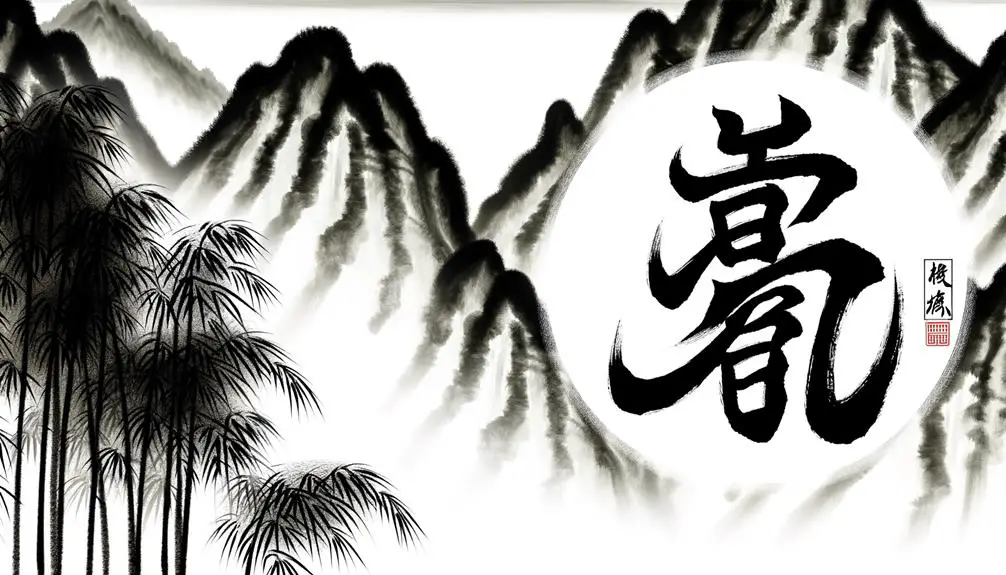
Chinese art and literature have long used the tiger symbol to convey themes of strength, valor, and mysticism.
In classical literature, tigers often represent formidable warriors and protectors against evil. The tiger's presence in poetry and prose emphasizes its importance as a symbol of courage and ferocity.
In visual arts, traditional Chinese paintings frequently show tigers in dynamic poses, highlighting their physical strength and spiritual essence. These artistic representations are not simply decorations but hold deep symbolic meanings, reflecting societal values and philosophical beliefs.
The tiger's imagery is intricately intertwined with narrative and aesthetic elements, demonstrating its lasting impact on Chinese cultural expressions and the collective consciousness.
Festivals and Celebrations
In various traditional festivals and celebrations, the tiger symbol plays a pivotal role in embodying themes of bravery and protection. This emblematic animal is intricately woven into the cultural fabric of Chinese festivities, reflecting deep-rooted historical significance and societal values.
The following points illustrate the tiger's prominence in such events:
- Lunar New Year: The Year of the Tiger, recurring every 12 years, is celebrated with various rituals invoking strength and courage.
- Dragon Boat Festival: Tiger motifs are often used on boats and paddles to ward off evil and secure safe passage.
- Mid-Autumn Festival: Tiger-themed lanterns symbolize protection and are a common sight.
- Double Ninth Festival: Participants wear tiger-head shoes to honor ancestors and call upon protective spirits.
These traditions underscore the tiger's enduring symbolic significance.
Modern Interpretations

Contemporary depictions of the tiger in Chinese culture seamlessly blend traditional symbolism with modern values, reflecting an evolving yet enduring reverence for this majestic animal.
The tiger, historically emblematic of strength and bravery, now also signifies qualities such as assertiveness and leadership in contemporary contexts.
Artistic representations in modern media, such as digital art and cinema, frequently incorporate the tiger's image to symbolize resilience and dynamism.
Moreover, in business and entrepreneurship, the tiger epitomizes tenacity and strategic acumen, aligning with the competitive spirit of today's global economy.
This duality of ancient reverence and modern adaptation underscores the tiger's versatile role in Chinese culture, highlighting a sophisticated synthesis of past and present ideals.
Influence on Daily Life
Beyond its representation in art and media, the tiger's symbolism profoundly permeates everyday life, influencing interpersonal relationships, personal aspirations, and social behaviors in nuanced ways. This pervasive influence can be observed through various facets:
- Interpersonal Relationships: The tiger symbolizes courage and strength, encouraging individuals to be more assertive and resilient in their interactions.
- Personal Aspirations: Emulating the tiger's traits, individuals often aim for leadership, ambition, and unwavering perseverance in their goals.
- Social Behaviors: Social norms and behaviors may reflect the tiger's attributes, promoting a culture of bravery and determination.
- Cultural Celebrations: Festivals and traditions often showcase tiger motifs, reinforcing its cultural significance and impact on collective identity.
These elements demonstrate the tiger's deep-rooted impact on daily life.
Conclusion
As a potent symbol, the tiger in Chinese culture encapsulates a rich tapestry of historical significance, mythological depth, and multifaceted symbolic meanings. Its presence permeates art, literature, and daily life, serving as a guardian in festivals and a motif in modern interpretations.
The tiger's enduring legacy continues to shape cultural representations, embodying strength, courage, and protection. Therefore, the tiger remains an indelible emblem of Chinese heritage, reflecting the profound interplay between tradition and contemporary society.

